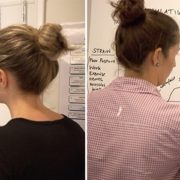Tradie Health Month! Are you at risk of injury?
August is Tradie Health Month and we wanted to thank all the wonderful tradies for doing what they do! With that said, the work involved on a day to day basis for tradies can often be demanding on your body.
There is an ever increasing number of injuries that occur when tradies are working. Did you know that 1 in 5 workplace injuries involve those working on the tools? What you may not know is that the predominant amount of these injuries are preventable – Physio Alistair has all the details!
How to tell if your body may be at risk of injury
Before a painful injury occurs there are often clues that the body is being exposed to strain. You may feel tightness or soreness in your muscles, stiffness through your back, or perhaps there will be days where a body part aches, and then the next day it feels totally fine. These are all signs that your body is under too much strain and there is a limitation causing the body not to move as well as it should.
Strategies to prevent injury
-
- See a physio – A physiotherapist will assess your movements, muscles and joints to see where your body is limited. At Barefoot we will treat the cause of your movement limitations and teach you strategies to maintain good movement. Once your body is able to move better you are less likely to load up other body structures which may be compensating for poor movement in another area of your body. The result is better movement, less pain and stiffness, and more knowledge on how you can best look after yourself.
- Develop a technique to keep your back in it’s optimal position while performing heavy physical tasks. If you’ve ever experienced an episode of back pain you’ll know how debilitating it can be. Any movement at all feels uncomfortable and you can’t do the physical activities required for everyday life. To prevent injury to the back it is helpful to learn what in fact neutral spine is and how it feels to move maintaining neutral. We call this this the two-hand check and have adapted it from the book Becoming a Supple Leopard by Kelly Starrett. Here’s how to do it:
-
- Place one hand at the bottom of your sternum with your palm facing down and your other hand at your pubic bone palm up. This should create two parallel horizontal planes – the top hand represents the bottom of the ribcage while the bottom hand represents the pelvis.
- Lean back and forward and notice how your hands move apart when you’re overextended and together when you’re rounded forward. These are indications that your spine isn’t in neutral. While the spine LOVES to move (and we love it to do so!) when a task is heavy it is best to maintain neutral spine as this places the least amount of strain on it.
- Have a go with your mates seeing if you can do a squat while maintaining neutral spine!


 ( See from left to right – Neutral, Extended, Bent)
( See from left to right – Neutral, Extended, Bent)
3. Get your work mates involved to call you out when you’re in a poor position! See your buddy hunched over in some funky position when he’s lifting something? – let him know about it! It’s easy to fall back into old habits and ways of moving and we all need reminders to stay in a position that’s going to prevent injury. Having others to keep you accountable in maintaining a good position will help you build this habit and prevent injury long term.
Want to learn more, or pop in to see one of the Barefoot Team? Click here. To get involved visit the Tradies health Facebook page or the Tradies health website.







